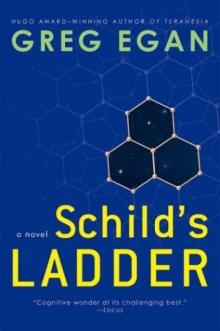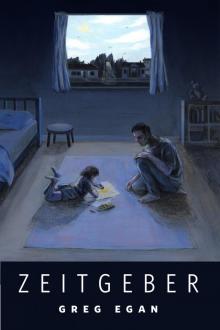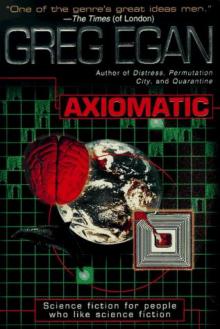Permutation City Read online
Page 3
Maria invoked Camel’s Eye, and told it, “Update my mask so it reacts as I did in that exchange.”
A brief silence followed. Maria imagined the synaptic weighting parameters being juggled in the mask’s neural net, as the training algorithm hunted for values which would guarantee the required response. She thought: If I keep on doing this, the mask is going to end up as much like me as a fully-fledged Copy. And what’s the point of saving yourself from the tedium of talking to junk mail if … you’re not? It was a deeply unpleasant notion … but masks were orders of magnitude less sophisticated than Copies; they had about as many neurons as the average goldfish – organized in a far less human fashion. Worrying about their “experience” would be as ludicrous as feeling guilty about terminating junk mail.
Camel’s Eye said, “Done.”
It was only 8:15. The whole day loomed ahead, promising nothing but bills. With no contract work coming in for the past two months, Maria had written half a dozen pieces of consumer software – mostly home security upgrades, supposedly in high demand. So far, she’d sold none of them; a few thousand people had read the catalog entries, but nobody had been persuaded to download. The prospect of embarking on another such project wasn’t exactly electrifying – but she had no real alternative. And once the recession was over and people started buying again, it would have been time well spent.
First, though, she needed to cheer herself up. If she worked in the Autoverse, just for half an hour or so – until nine o’clock at the latest – then she’d be able to face the rest of the day…
Then again, she could always try to face the rest of the day without bribing herself, just once. The Autoverse was a waste of money, and a waste of time – a hobby she could justify when things were going well, but an indulgence she could ill afford right now.
Maria put an end to her indecision in the usual way. She logged on to her Joint Supercomputer Network account – paying a fifty-dollar fee for the privilege, which she now had to make worthwhile. She slipped on her force gloves and prodded an icon, a wireframe of a cube, on the terminal’s flatscreen – and the three-dimensional workspace in front of the screen came to life, borders outlined by a faint holographic grid. For a second, it felt like she’d plunged her hand into some kind of invisible vortex: magnetic fields gripped and twisted her glove, as start-up surges tugged at the coils in each joint at random – until the electronics settled into equilibrium, and a message flashed up in the middle of the workspace: YOU MAY NOW PUT ON YOUR GLOVES.
She jabbed another icon, a starburst labeled FIAT. The only visible effect was the appearance of a small menu strip hovering low in the foreground – but to the cluster of programs she’d invoked, the cube of thin air in front of her terminal now corresponded to a small, empty universe.
Maria summoned up a single molecule of nutrose, represented as a ball-and-stick model, and, with a flick of a gloved forefinger, imparted a slow spin. The vertices of the crimped hexagonal ring zig-zagged above and below the molecule’s average plane; one vertex was a divalent blue atom, linked only to its neighbors in the ring; the other five were all tetravalent greens, with two bonds left over for other attachments. Each green was joined to a small, monovalent red – on the top side if the vertex was raised, on the bottom if it was lowered – and four of them also sprouted short horizontal spikes, built from a blue and a red, pointing away from the ring. The fifth green held out a small cluster of atoms instead: a green with two reds, and its own blue-red spike.
The viewing software rendered the molecule plausibly solid, taking into account the effects of ambient light; Maria watched it spin above the desktop, admiring the not-quite-symmetrical form. A real-world chemist, she mused, would take one look at this and say: Glucose. Green is carbon, blue is oxygen, red is hydrogen … no? No. They’d stare awhile; put on the gloves and give the impostor a thorough grope; whip a protractor out of the toolbox and measure a few angles; invoke tables of bond formation energies and vibrational modes; maybe even demand to see nuclear magnetic resonance spectra (not available – or, to put it less coyly, not applicable). Finally, with the realization of blasphemy dawning, they’d tear their hands from the infernal machinery, and bolt from the room screaming, “There is no Periodic Table but Mendeleev’s! There is no Periodic Table but Mendeleev’s!”
The Autoverse was a “toy” universe, a computer model which obeyed its own simplified “laws of physics” – laws far easier to deal with mathematically than the equations of real-world quantum mechanics. Atoms could exist in this stylized universe, but they were subtly different from their real-world counterparts; the Autoverse was no more a faithful simulation of the real world than the game of chess was a faithful simulation of medieval warfare. It was far more insidious than chess, though, in the eyes of many real-world chemists. The false chemistry it supported was too rich, too complex, too seductive by far.
Maria reached into the workspace again, halted the molecule’s spin, deftly plucked both the lone red and the blue-red spike from one of the greens, then reattached them, swapped, so that the spike now pointed upward. The gloves’ force and tactile feedback, the molecule’s laser-painted image, and the faint clicks that might have been plastic on plastic as she pushed the atoms into place, combined to create a convincing impression of manipulating a tangible object, built out of solid spheres and rods.
This virtual ball-and-stick model was easy to work with – but its placid behavior in her hands had nothing to do with the physics of the Autoverse, temporarily held in abeyance. Only when she released her grip was the molecule allowed to express its true dynamics, oscillating wildly as the stresses induced by the alteration were redistributed from atom to atom, until a new equilibrium geometry was found.
Maria watched the delayed response with a familiar sense of frustration; she could never quite resign herself to accepting the handling rules, however convenient they were. She’d thought about trying to devise a more authentic mode of interaction, offering the chance to feel what it was “really like” to grasp an Autoverse molecule, to break and re-form its bonds – instead of everything turning to simulated plastic at the touch of a glove. The catch was, if a molecule obeyed only Autoverse physics – the internal logic of the self-contained computer model – then how could she, outside the model, interact with it at all? By constructing little surrogate hands in the Autoverse, to act as remote manipulators? Construct them out of what? There were no molecules small enough to build anything finely structured, at that scale; the smallest rigid polymers which could act as “fingers” would be half as thick as the entire nutrose ring. In any case, although the target molecule would be free to interact with these surrogate hands according to pure Autoverse physics, there’d be nothing authentic about the way the hands themselves magically followed the movements of her gloves. Maria could see no joy in simply shifting the point where the rules were broken – and the rules had to be broken, somewhere. Manipulating the contents of the Autoverse meant violating its laws. That was obvious … but it was still frustrating.
She saved the modified sugar, optimistically dubbing it mutose. Then, changing the length scale by a factor of a million, she started up twenty-one tiny cultures of Autobacterium lamberti, in solutions ranging from pure nutrose, to a fifty-fifty mixture, to one hundred per cent mutose.
She gazed at the array of Petri dishes floating in the workspace, their contents portrayed in colors which coded for the health of the bacteria. “False colors” … but that phrase was tautological. Any view of the Autoverse was necessarily stylized: a color-coded map, displaying selected attributes of the region in question. Some views were more abstract, more heavily processed than others – in the sense that a map of the Earth, color-coded to show the health of its people, would be arguably more abstract than one displaying altitude or rainfall – but the real-world ideal of an unadulterated, naked-eye view was simply untranslatable.
A few of the cultures were already looking decidedly sick, fading from electric
blue to dull brown. Maria summoned up a three-dimensional graph, showing population versus time for the full range of nutrient mixtures. The cultures with only a trace of the new stuff were, predictably, growing at almost the pace of the control; with increasing mutose substitution the ascent gradually slowed, until, around the eighty-five per cent line, the population was static. Beyond that were ever steeper trajectories into extinction. In small doses, mutose was simply irrelevant, but at high enough concentrations it was insidious: similar enough to nutrose – A. lamberti’s usual food – to be taken part-way through the metabolic process, competing for the same enzymes, tying up valuable biochemical resources … but eventually reaching a step where that one stray blue-red spike formed an insurmountable barrier to the reaction geometry, leaving the bacterium with nothing but a useless by-product and a net energy loss. A culture with ninety per cent mutose was a world where ninety per cent of the food supply had no nutritional value whatsoever – but had to be ingested indiscriminately along with the worthwhile ten per cent. Consuming ten times as much for the same return wasn’t a viable solution; to survive in the long term, A. lamberti would have to chance upon some means of rejecting mutose before wasting energy on it – or, better still, find a way to turn it back into nutrose, transforming it from a virtual poison into a source of food.
Maria displayed a histogram of mutations occurring in the bacteria’s three nutrose epimerase genes; the enzymes these genes coded for were the closest things A. lamberti had to a tool to render mutose digestible – although none, in their original form, would do the job. No mutants had yet persisted for more than a couple of generations; all the changes so far had evidently done more harm than good. Partial sequences of the mutant genes scrolled by in a small window; Maria gazed at the blur of codons, and mentally urged the process on – if not straight toward the target (since she had no idea what that was), then at least … outward, blindly, into the space of all possible mistakes.
It was a nice thought. The only trouble was, certain portions of the genes were especially prone to particular copying errors, so most of the mutants were “exploring” the same dead ends, again and again.
Arranging for A. lamberti to mutate was easy; like a real-world bacterium, it made frequent errors every time it duplicated its analog of DNA. Persuading it to mutate “usefully” was something else. Max Lambert himself – inventor of the Autoverse, creator of A. lamberti, hero to a generation of cellular-automaton and artificial-life freaks – had spent much of the last fifteen years of his life trying to discover why the subtle differences between real-world and Autoverse biochemistry made natural selection so common in one system, and so elusive in the other. Exposed to the kind of stressful opportunities which E. coli would have exploited within a few dozen generations, strain after strain of A. lamberti had simply died out.
Only a few die-hard enthusiasts still continued Lambert’s work. Maria knew of just seventy-two people who’d have the slightest idea what it meant if she ever succeeded. The artificial life scene, now, was dominated by the study of Copies – patchwork creatures, mosaics of ten thousand different ad hoc rules … the antithesis of everything the Autoverse stood for.
Real-world biochemistry was far too complex to simulate in every last detail for a creature the size of a gnat, let alone a human being. Computers could model all the processes of life – but not on every scale, from atom to organism, all at the same time. So the field had split three ways. In one camp, traditional molecular biochemists continued to extend their painstaking calculations, solving Schrödinger’s equation more-or-less exactly for ever larger systems, working their way up to entire replicating strands of DNA, whole mitochondrial sub-assemblies, significant patches of the giant carbohydrate chain-link fence of a cell wall … but spending ever more on computing power for ever diminishing returns.
At the other end of the scale were Copies: elaborate refinements of whole-body medical simulations, originally designed to help train surgeons with virtual operations, and to take the place of animals in drug tests. A Copy was like a high-resolution CAT scan come to life, linked to a medical encyclopedia to spell out how its every tissue and organ should behave … walking around inside a state-of-the-art architectural simulation. A Copy possessed no individual atoms or molecules; every organ in its virtual body came in the guise of specialized sub-programs which knew (in encyclopedic, but not atomic, detail) how a real liver or brain or thyroid gland functioned … but which couldn’t have solved Schrödinger’s equation for so much as a single protein molecule. All physiology, no physics.
Lambert and his followers had staked out the middle ground. They’d invented a new physics, simple enough to allow several thousand bacteria to fit into a modest computer simulation, with a consistent, unbroken hierarchy of details existing right down to the subatomic scale. Everything was driven from the bottom up, by the lowest level of physical laws, just as it was in the real world.
The price of this simplicity was that an Autoverse bacterium didn’t necessarily behave like its real-world counterparts. A. lamberti had a habit of confounding traditional expectations in bizarre and unpredictable ways – and for most serious microbiologists, that was enough to render it worthless.
For Autoverse junkies, though, that was the whole point.
Maria brushed aside the diagrams concealing her view of the Petri dishes, then zoomed in on one thriving culture, until a single bacterium filled the workspace. Color-coded by “health” it was a featureless blue blob, but even when she switched to a standard chemical map there was no real structure visible, apart from the cell wall – no nucleus, no organelles, no flagella; A. lamberti wasn’t much more than a sac of protoplasm. She played with the representation, making the fine strands of the unraveled chromosomes appear; highlighting regions where protein synthesis was taking place; rendering visible the concentration gradients of nutrose and its immediate metabolites. Computationally expensive views; she cursed herself (as always) for wasting money, but failed (as always) to shut down everything but the essential analysis software (and the Autoverse itself), failed to sit gazing into thin air, waiting patiently for a result.
Instead, she zoomed in closer, switched to atomic colors (but left the pervasive aqua molecules invisible), temporarily halted time to freeze the blur of thermal motion, then zoomed in still further until the vague specks scattered throughout the workspace sharpened into the intricate tangles of long-chain lipids, polysaccharides, peptidoglycans. Names stolen unmodified from their real-world analogs – but screw it, who wanted to spend their life devising a whole new biochemical nomenclature? Maria was sufficiently impressed that Lambert had come up with distinguishable colors for all thirty-two Autoverse atoms, and unambiguous names to match.
She tracked through the sea of elaborate molecules – all of them synthesized by A. lamberti from nothing but nutrose, aqua, pneuma, and a few trace elements. Unable to spot any mutose molecules, she invoked Maxwell’s Demon and asked it to find one. The perceptible delay before the program responded always drove home to her the sheer quantity of information she was playing with – and the way in which it was organized. A traditional biochemical simulation would have been keeping track of every molecule, and could have told her the exact location of the nearest altered sugar, almost instantaneously. For a traditional simulation, this catalog of molecules would have been the “ultimate truth” – nothing would have “existed”, except by virtue of an entry in the Big List. In contrast, the “ultimate truth” of the Autoverse was a vast array of cubic cells of subatomic dimensions – and the primary software dealt only with these cells, oblivious to any larger structures. Atoms in the Autoverse were like hurricanes in an atmospheric model (only far more stable); they arose from the simple rules governing the smallest elements of the system. There was no need to explicitly calculate their behavior; the laws governing individual cells drove everything that happened at higher levels. Of course, a swarm of demons could have been used to compile and maintain a kind of ce
nsus of atoms and molecules – at great computational expense, rather defeating the point. And the Autoverse itself would have churned on, regardless.
Maria locked her viewpoint to the mutose molecule, then restarted time, and everything but that one hexagonal ring smeared into translucence. The molecule itself was only slightly blurred; the current representational conventions made the average positions of the atoms clearly visible, with the deviations due to bond vibration merely suggested by faint ghostly streaks.
She zoomed in until the molecule filled the workspace. She didn’t know what she was hoping to see: a successful mutant epimerase enzyme suddenly latch onto the ring and shift the aberrant blue-red spike back into the horizontal position? Questions of probability aside, it would have been over before she even knew it had begun. That part was easily fixed: she instructed Maxwell’s Demon to keep a rolling buffer of a few million clock ticks of the molecule’s history, and to replay it at a suitable rate if any structural change occurred.
Embedded in a “living” organism, the mutose ring looked exactly the same as the prototype she’d handled minutes before: red, green and blue billiard balls, linked by thin white rods. It seemed like an insult for even a bacterium to be composed of such comic-book molecules. The viewing software was constantly inspecting this tiny region of the Autoverse, identifying the patterns that constituted atoms, checking for overlaps between them to decide which was bonded to which, and then displaying a nice, neat, stylized picture of its conclusions. Like the handling rules which took this representation at face value, it was a useful fiction, but…
Maria slowed down the Autoverse clock by a factor of ten billion, then popped up the viewing menu and hit the button marked RAW. The tidy assembly of spheres and rods melted into a jagged crown of writhing polychromatic liquid metal, waves of color boiling away from the vertices to collide, merge, flow back again, wisps licking out into space.

 Zendegi
Zendegi Permutation City
Permutation City The Eternal Flame
The Eternal Flame Artifacts
Artifacts Wang's Carpets
Wang's Carpets Dichronauts
Dichronauts Incandescence
Incandescence Teranesia
Teranesia Schild's Ladder
Schild's Ladder Quarantine
Quarantine The Four Thousand, the Eight Hundred
The Four Thousand, the Eight Hundred The Clockwork Rocket
The Clockwork Rocket Zeitgeber
Zeitgeber Phoresis
Phoresis The Nearest
The Nearest Diaspora
Diaspora Instantiation
Instantiation Distress
Distress An Unusual Angle
An Unusual Angle Oceanic
Oceanic The Arrows of Time
The Arrows of Time Axiomatic
Axiomatic![Anthology 2. Luminous [1998, 2010] Read online](http://i1.bookreadfree.com/i/03/18/anthology_2_luminous_1998_2010_preview.jpg) Anthology 2. Luminous [1998, 2010]
Anthology 2. Luminous [1998, 2010] Perihelion Summer
Perihelion Summer Luminous
Luminous